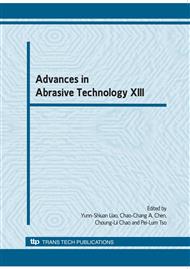p.171
p.177
p.181
p.189
p.195
p.202
p.208
p.214
p.220
Tool Wear Mechanism in Continuous Cutting of Difficult-to-Cut Material under Dry Machining
Abstract:
Wear mechanism on the flank of a cutting tool is caused by friction between newly machined surface and the cutting tool, which plays predominant role in determining tool life. Detailed study on wear mechanism at the cutting edge of carbide tools were carried out at cutting speed of 55 – 95 m/min, feed rate of 0.15 – 0.35 mm/rev and depth of cut of 0.10 – 0.20 mm. The wear on the cutting tools was occurred predominantly on the nose radius, as effect of lower feedrate and nose radius selected. Various wear observed on both coated and uncoated cutting tool such as abrasive wear, adhesive wear, adhering chip on the cutting edge, flaking, chipping, coating delamination of coated tool, crack and fracture. The abrasive wear predominantly occurred on the flank face while the flaking on the rake face. Abrasive wear occurred at nose radius due to the depth of cut selected was low therefore, the contact area between the cutting tool and the workpiece material was small. Adhesion or welded titanium alloy onto the flank and rake faces demonstrated a strong bond at the workpiece-tool interface. The adhesion wear takes place after the coating has worn out or coating delamination has been occurred. The crack occurred possibly due to machining at high cutting speed and high depth of cut. Cutting at high cutting speed caused more heat generated at the cutting edge and at high depth of cut caused more cutting forces on the insert.
Info:
Periodical:
Pages:
195-201
Citation:
Online since:
August 2010
Keywords:
Price:
Сopyright:
© 2010 Trans Tech Publications Ltd. All Rights Reserved
Share:
Citation:


